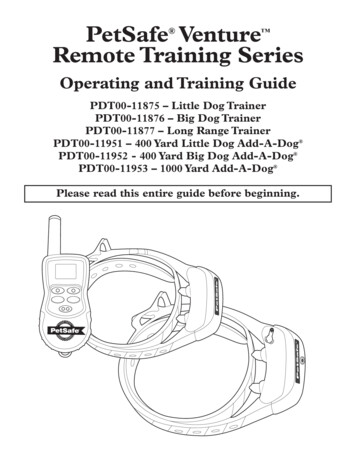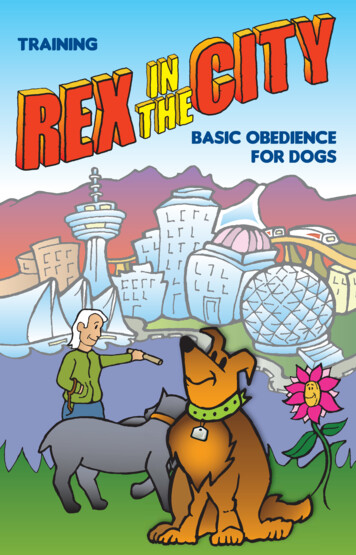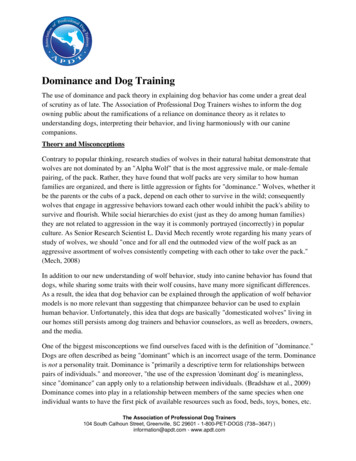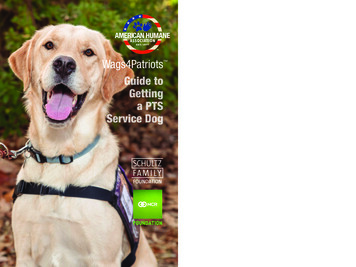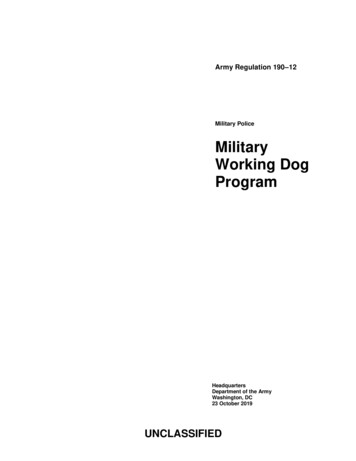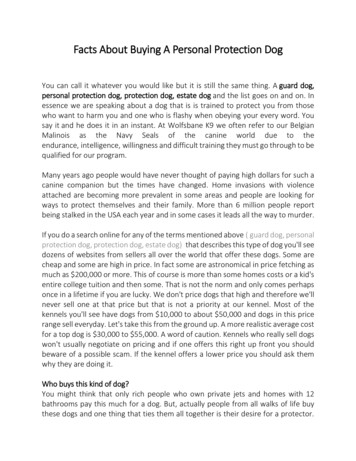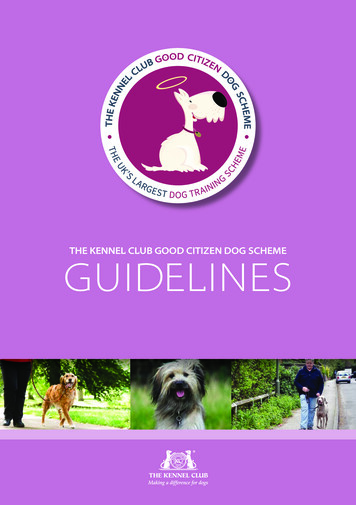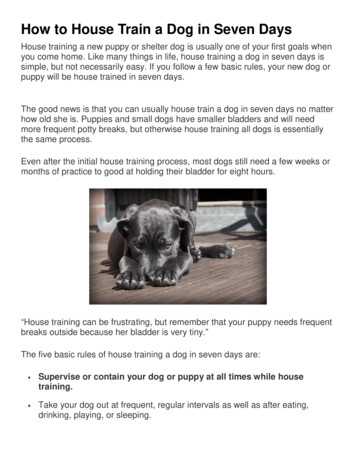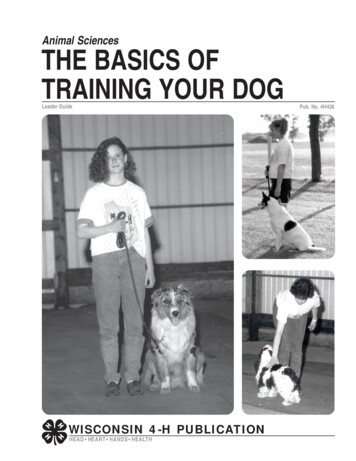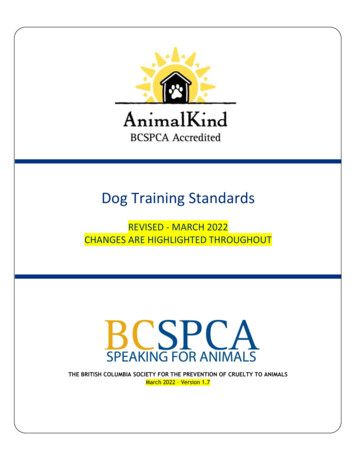
Transcription
Dog Training StandardsREVISED - MARCH 2022CHANGES ARE HIGHLIGHTED THROUGHOUTTHE BRITISH COLUMBIA SOCIETY FOR THE PREVENTION OF CRUELTY TO ANIMALSMarch 2022 – Version 1.7
Standards for Dog TrainingThese standards were developed by:Joanna Makowska (PhD), Adjunct Professor, Animal Welfare Program, University of BritishColumbiaKim Monteith (CTC), Manager, Animal Behaviour & Welfare, BC SPCAKaren van Haaften (DVM, DACVB), Senior Manager, Behaviour & Welfare, BC SPCANicole Fenwick (M.Sc.), Manager, Research & Standards, BC SPCAWith contributions from:Sara Dubois (PhD), Chief Scientific Officer, BC SPCAEmilia Gordon (DVM), Senior Manager, Animal Health, BC SPCAAmy Morris (M.Sc.), Manager, Public Policy & Outreach, BC SPCAAcknowledgementsThe BC SPCA gratefully acknowledges the animal welfare expertise and leadership of the UBC AnimalWelfare Program, and thanks the following individuals and groups for their valuable input andfeedback on earlier drafts of this document: Kristi Benson (CTC), Jean Donaldson (CTC), NadineGourkow (PhD), Lynn Hewison (M.Sc.), Rebecca Ledger (PhD, APBC), Julia Lomb (DVM (Germany)),Lee Niel (PhD), Chirag Patel (PGCert (CAB)), Claudia Richter (DVM), Erin Ryan (BSc), Zazie Todd (PhD,CTC), dog trainer consultation participants, and dog trainer survey participants. We also thank thePeter Wall Institute for Advanced Studies and the Vancouver Foundation for funding and makingpossible the development of the AnimalKind accreditation program.Copyright BC SPCA 2022 Version 1.7Page 2 of 29
Standards for Dog TrainingContentsPreface .4Introduction .5Why is the BC SPCA accrediting dog training businesses? .5How were the Standards developed? .5Which dogs do the Standards apply to? .5What is dog training? .6Which businesses can be accredited? .6How does the accreditation process work? .6AnimalKind Dog Training Standards .7Standard 1: Humane methods that are reward-based and evidence-based are used to train dogs .7Standard 2: Training methods, devices or tools that cause pain, injury, anxiety, fear or distress to thedog are not used.9Standard 3: Business models align with a commitment to protect dog welfare . 12Standard 4: Ethical and legal business practices are followed . 13Standard 5: Trainers are qualified in humane training that is reward-based and evidence-based . 14Standard 6: Trainers do not act beyond their professional qualifications . 16Standard 7: Trainers exhibit a high level of professionalism and ethical behaviour . 18Standard 8: Assistants are qualified in humane dog handling . 18Standard 9: Trainers ensure clients understand the training methods that will be used . 19Standard 10: Dogs’ emotional well-being is prioritized at all times during training sessions. 19Standard 11: Training environments are healthy and safe . 20Standard 12: Acts of cruelty and neglect are not tolerated . 21References . 22Appendix 1 – Definitions . 25Appendix 2 – Standard Operating Procedure Required Topics. 27Appendix 3 – Example Template for Assistant Training Record . 28Appendix 4 –Assessment Criteria for Trainer Certificates and Certifications . 29Copyright BC SPCA 2022 Version 1.7Page 3 of 29
Standards for Dog TrainingPrefaceTo help more animals in the community, the BC SPCA and the University of British Columbia (UBC) AnimalWelfare Program recognized the need to evaluate and promote animal-related businesses that arecommitted to good welfare practices within their industry. Through this research partnership, AnimalKind –the BC SPCA’s animal welfare accreditation and referral program – was created. AnimalKind businesses usescience-based practices and share BC SPCA values. AnimalKind was developed with funding from the PeterWall Institute for Advanced Studies and the Vancouver Foundation.The BC SPCA is one of the largest animal welfare organizations of its kind in North America. Established in1895 under the provincial Prevention of Cruelty to Animals Act (PCA Act), the Society’s mandate is to protectand enhance the quality of life for domestic, farm and wild animals in British Columbia (BC). As a registeredcharity, the BC SPCA operates community animal centres, education and adoption facilities, veterinary andspay/neuter clinics, a wildlife rehabilitation centre, a provincial call centre, and a provincial office. In additionto province-wide programs for advocacy, government relations, humane education, and scientific research,Special Provincial Constables enforce the PCA Act and Criminal Code of Canada to fulfill the Society’s lawenforcement functions.Copyright BC SPCA 2022 Version 1.7Page 4 of 29
Standards for Dog TrainingIntroductionWhy is the BC SPCA accrediting dog training businesses?The BC SPCA values the important role that dog training professionals play in helping dogs learn andsocialize, and helping guardians (i.e., owners) achieve their training goals and build positive relationshipswith their dogs. To promote humane, reward-based dog training practices, the BC SPCA has developedevidence-based standards that reflect animal welfare values.To help our supporters and the public choose a dog trainer, the BC SPCA will be offering an AnimalKindaccreditation program to dog training businesses in BC, and its own dog training services at a select numberof its facilities. Through AnimalKind, the BC SPCA aims to connect more dog guardians with trainers who usehumane training methods that are reward-based and evidence-based. Humane training refers to the trainingor caring for an animal without using pain, fear, physical or verbal intimidation techniques. Similarly, rewardbased training refers to any training technique, tool or device that the dog does not perceive as physically oremotionally uncomfortable. Evidence-based training methods are methods that are informed by objectiveevidence, including data and peer-reviewed scientific literature. Throughout this document, please refer toAppendix 1 for these and other definitions.We also envision that the AnimalKind community of dog training businesses will contribute to publiceducation about the importance of humane training methods that are reward-based and evidence-based toimprove the welfare of dogs in BC.How were the Standards developed?Research and development of the AnimalKind Dog Training Standards (the “Standards”) was informed by: ascientific literature review of the effects of dog training methods on dog welfare and learning ability(performed for the BC SPCA by Dr. Joanna Makowska) 1; peer-review by local and international animalbehaviour and training experts; in-person discussions and written feedback from BC dog trainers; widelyaccepted ethical principles and animal behaviour and welfare science; existing dog training standards andposition statements; and applicable laws of BC and Canada. These Standards also reflect the values of the BCSPCA as expressed in Position Statements (in particular, Position Statements on: Animal Training 2, DogWelfare 3, Companion Animal Handling and Restraint 4, and Companion Animal Confinement 5).The BC SPCA acknowledges that scientific knowledge is continually evolving, and that scientific evidence onsome topics related to dog training is still lacking. These Standards are based on the evidence currentlyavailable and will be updated as new evidence comes to light. Where scientific evidence is not yet available,the values of the BC SPCA were used to guide Standards development.Which dogs do the Standards apply to?The term “dog” refers to domestic dogs of all ages in the species Canis lupus. The Standards apply to thetraining of all dogs, including pet dogs, shelter dogs, sport dogs and working dogs (e.g., assistance dogs,police dogs).Copyright BC SPCA 2022 Version 1.7Page 5 of 29
Standards for Dog TrainingWhat is dog training?Dog training refers to actions undertaken to manage or modify a dog's behaviour at all ages, includingactivities aimed at socializing dogs, teaching dogs to perform desired behaviours and inhibit undesiredbehaviours, and preventing the development of problem behaviours.Dog training also refers to teaching dog guardians how to humanely manage or modify their dog’sbehaviour, and teaching guardians about normal dog behaviour, dog communication and dog bodylanguage. Some examples include puppy classes, group classes, agility classes and one-on-one individualizedlessons.Which businesses can be accredited?The Standards apply to organizations or businesses that provide dog training services (i.e. “dog trainingbusinesses” or “training businesses”). Accreditation is given to dog training businesses, not to individualtrainers. All trainers within a dog training business must meet the Standards for the business to beaccredited. A dog training business may consist of one (sole proprietor) or more trainers.The Standards are not intended for businesses whose mandate is to provide specialized services that gobeyond dog training (e.g., members of the Association of Pet Behaviour Counsellors (APBC) or CertifiedApplied Animal Behaviorists (CAAB) working under veterinary referral, or Diplomates of the AmericanCollege of Veterinary Behavior (DACVB)). The BC SPCA does not currently accredit entities outside of BC.How does the accreditation process work?Accreditation is voluntary, and initiated by the dog training business interested in becoming accredited.To be eligible for accreditation, a dog training business must adhere to the Standards (which outlineacceptable and prohibited actions) and the AnimalKind Accreditation Program Operations Manual (the“Operations Manual”, which outlines the terms and conditions of accreditation as well as the complaints andappeals processes). In addition, AnimalKind accredited dog training businesses are expected to adhere to allCanadian federal, provincial and territory acts and regulations, and municipal bylaws related to animalcruelty, care and transportation.Accreditation requires the training business to participate in an audit to establish that the Standards aremet. Accreditation is renewed yearly and may involve an annual re-accreditation audit. As a BC SPCA nonprofit initiative, AnimalKind aims to be sustainable by recovering a portion of operating costs through feescharged to the AnimalKind accredited businesses.Copyright BC SPCA 2022 Version 1.7Page 6 of 29
Standards for Dog TrainingAnimalKind Dog Training StandardsStandard 1: Humane methods that are reward-based and evidence-based are used to train dogs1.1.Training methods used and taught by trainers focus on rewarding dogs and positively reinforcingdesired behaviours.1.2.Training methods used and taught by trainers focus on removal of a reward, differentialreinforcement of an incompatible behaviour, counterconditioning or desensitization andcounterconditioning to extinguish undesired behaviours or change emotional states.1.3.Training methods used and taught by trainers emphasize positive dog-human relationships toenhance communication.1.4.Dog training businesses must have a written animal welfare policy and/or mission statement tocommunicate expectations to trainers and assistants regarding animal care and handling (seeAppendix 2 for required elements of policy).1.5. Trainers and assistants must demonstrate awareness of the business’s animal welfare policy.In the case of an emergency situation likely to result in harm or injury to a person or animal, trainers mayuse a quick intervention that does not otherwise conform to the Standards in order to ensure safety (e.g.,grabbing a dog to stop an attack).A number of scientific studies have assessed the effects of training dogs with reward-based methods versusaversive-based methods on dog welfare. Dogs observed by researchers during training were found to displaymore stress-related behaviours (e.g., lower posture, more lip licking) when trained with aversive-basedmethods compared to reward-based methods 6,7. These stress-related behaviours persisted even after thedogs were responding reliably and the aversive stimulus was no longer used, suggesting that verbal cuesthemselves had become aversive. Studies like these suggest that the use of aversive-based methods canadversely affect dogs’ welfare immediately and long-term.Surveys of dog owners have shown that more frequent reported use of aversive-based methods, whetheralone or in combination with reward-based methods, is associated with more frequent reporting ofaggression and other problem behaviours, while more frequent reported use of reward-based methodsalone is associated with less frequent reporting of aggression and other behaviour problems 8–14. Thisrelationship does not imply causality (i.e., it does not show whether using aversive-based methods leads toaggression and other behaviour problems, or whether the presence of aggression and other behaviourproblems leads dog guardians to resort to using aversive-based methods). However, this relationship doesimply that aversive-based techniques – as used by respondents of these surveys, who were not professionals– have not proven effective in eliminating problem behaviour. Indeed, results from surveys indicate thatreward-based training is more effective than aversive-based training when used by non-professionals 8,13,15.Training with the use of aversive-based methods by professional dog trainers may be as effective as trainingwith the use of reward-based methods, but not without the potential for compromised welfare or thedevelopment of other problem behaviours 16.Copyright BC SPCA 2022 Version 1.7Page 7 of 29
Standards for Dog TrainingIn addition, two recently published literature reviews analyzing the bulk of the scientific papers on theeffects of aversive-based training methods in dogs have concluded that aversive training methods pose risksto dog welfare by jeopardizing physical and mental health of dogs 17,18.The BC SPCA acknowledges that no one scientific study is ‘perfect’; however, taken together, results from 9empirical studies, 10 survey-based studies and 2 review papers point towards the same conclusion: aversivebased methods have negative welfare consequences on dogs, and there is no evidence that these methodsare any more effective than reward-based methods.In 2016, the BC SPCA adopted a Position Statement on Animal Training 2 to advocate “for the use of forcefree, humane training techniques utilizing science-based learning theories which foster trust and buildpositive human-animal relationships.” Similar positions advocating for the use of humane, reward-based andevidence-based methods have been adopted by other animal protection 19–24 and veterinary 25–29organizations and associations for professional animal trainers 30–33 in Canada and worldwide.Copyright BC SPCA 2022 Version 1.7Page 8 of 29
Standards for Dog TrainingStandard 2: Training methods, devices or tools that cause pain, injury, anxiety, fear or distress to thedog are not used2.1. Use or teaching of any training method, device or tool that is designed to cause, or that causes, pain,injury, anxiety, fear or distress to the dog is prohibited.2.2. Use of any method, device or tool that a particular dog has a consistent aversive reaction to isprohibited for that dog (even if the method, device or tool is not designed to be aversive).2.3. Use, teaching, sale or advertising of the following aversive training methods, devices or tools isprohibited:Training methods hitting, ‘bonking’, poking, punching, kneeing,kicking, pinching, jabbing, squeezing or bitingany part of the dog’s body pinning the dog on the ground (“alpha roll”) forceful restraint (e.g., holding by the tail orfeet, head lock) holding the dog under water asphyxiation, including hanging orhelicoptering choking with hands rubbing the dog’s face in urine or feces scruff shaking throwing or pushing the dog throwing anything at the dog to cause pain or fearstartling noise (e.g., coin tin)forcing anything down a dog’s throatfood or water deprivationphysical confinement used to punish the dogprolonged social isolation used to punish the dogharsh verbal correctionsspray bottleleash corrections (‘pop’)cinching of thorax, abdomen, or prepuce with aleash (e.g., manually looping leash orThunderLeash) or harness (e.g., LUPI Harness)Training devices and tools electronic shock (aka static) collars (including remote activated, bark activated and boundary fences)prong (aka pinch) collars (including plastic and metal)choke chainsslip collars and slip leashesanti-bark collars (any type)spray collars (e.g., scented spray, compressed air)muzzles that prevent panting or drinkingThe training methods, devices and tools listed above are prohibited because they are likely to cause pain,fear, distress, physical injury or death, and may result in increased behavioural problems, includingaggressive behaviour.Copyright BC SPCA 2022 Version 1.7Page 9 of 29
Standards for Dog TrainingIn the case of an emergency situation likely to result in harm or injury to a person or animal, trainers mayuse a quick intervention that does not otherwise conform to the Standards in order to ensure safety (e.g.,grabbing a dog to stop an attack).The list above is not exhaustive. Any method, device or tool that a particular dog has a consistent aversivereaction to is prohibited for that dog (even if the method, device or tool is not designed to be aversive).Where appropriate, trainers may use positive reinforcement and/or systematic desensitization andcounterconditioning to build a positive association with a method, device or tool that is not designed to beaversive; for example, a leash or a head halter.Hanging and helicoptering: There is at least one documented case of severe brain injury necessitatingeuthanasia following disciplinary ‘hanging’ of a dog by a choke chain 34. Several animal organizationsdescribe ‘hanging’ and ‘helicoptering’ as unacceptable training methods 20,35,36.Forceful restraint: Restraint used in training may be allowed only when done short-term by a trainer in thecontext of preparing a dog for its short-term use by a veterinarian or a groomer. Training should usesystematic desensitization and counterconditioning.Electronic shock collars: The use of electronic shock collars is illegal in Austria, Denmark, Finland, Germany,Norway, Slovenia, Sweden, Switzerland, Wales, and in the states of New South Wales, South Australia andthe Australian Capital Territory in Australia. Legislative bans are currently being implemented in England andScotland. The provincial Regulation respecting the safety and welfare of cats and dogs in Québec forbidscollars that cause pain or injury; consequently, the law recommends against the use of shock in dog training.Shock collars not only cause pain 16,37,38, but they also result in immediate 16,37–39 and long-term 38,40 negativeemotional consequences in dogs (even when used by experienced trainers and according to manufacturers’instructions). With regards to electronic fencing systems, the Canadian Veterinary Medical Association(CVMA) states that “some dogs become very agitated from the stimulus however minimal, and may becomefearful of their environment” 29. There is some documented evidence that dogs may cause injury to a personas a result of having received an electric shock from an electronic boundary fence system 41.There is no scientific evidence that training using a shock collar is more effective compared to training withreward-based methods. On the contrary, available evidence indicates that using a shock collar is lesseffective 42 or only as effective 16 as using a reward-based method. A number of Canadian and internationalanimal protection 20,23,24,43 and veterinary 25–29 organizations and associations for professional animal trainers30–32have spoken out against the use of electronic shock collars in dog training. Recently, the EuropeanSociety of Veterinary Clinical Ethology (ESVCE) has stated that they “position strongly against the use of ecollars in dog training, [ ] and urge all European countries to take an interest and position in this welfarematter” 44. This position was taken following a thorough literature review of the pros and cons of usingelectronic shock training devices in dogs 45.Electronic collars that are not capable of delivering shock but instead communicate with dogs usingvibrations or sounds, if conditioned as a secondary positive reinforcer, are acceptable with the exception ofuse as anti-bark devices (discussed below). For example, vibration collars may be used to communicate withdeaf dogs.Prong collars: Prong collars are illegal in Austria, Denmark, Switzerland, New Zealand and in the state ofVictoria in Australia; and they are not recommended in Québec per the provincial Regulation respecting thesafety and welfare of cats and dogs. Choke collars are illegal in Denmark and Switzerland. The use of prongor choke collars is associated with stress behaviours in dogs 37,38 and there is no evidence that they areCopyright BC SPCA 2022 Version 1.7Page 10 of 29
Standards for Dog Trainingassociated with better training success compared to non-punishment-based collars 46. Veterinaryorganizations strongly discourage the use of prong, choke and pinch collars in favour of more humanealternatives 28,29,47. Many other animal organizations 20,23,24,31,48 have voiced their opposition to the use ofprong collars and choke collars for dogs.Slip collars and slip leashes: Slip collars and slip leashes are not allowed as a training tool (e.g., slip collartightening used to train the dog not to pull on the leash). Slip leashes may be used as a short-termmanagement tool. For routine movement of animals, the use of tools which do not constrict around the neckare encouraged, such as flat buckle collars, harnesses, and martingale collars (only if appropriately fitted tothe circumference of the neck when tightened).Anti-bark collars: Anti-bark collars that emit sounds, vibrations, scented spray or a hiss of cold air when dogsvocalize instill anxiety 49; they may be effective in the moment, but they do not address the underlyingcause of the behaviour. RSPCA Australia 24 and the Association of Pet Dog Trainers UK 31 are explicitly againstthe use of any collars that emit aversive scents or sounds, while RSPCA South Australia 48 and the AustralianVeterinary Medical Association 27 denounce the use of citronella collars.Muzzles: Muzzles that allow natural behaviours such as panting or drinking (e.g., basket muzzles) arestrongly recommended. Use of more restrictive muzzles (e.g., nylon muzzles) as a training method to stopbarking or chewing is not permitted. Restrictive muzzles may be allowed only when used short-term (i.e., afew minutes) by a trainer in the context of preparing a dog for its short-term use by a veterinarian or agroomer.Any tools used with dogs must be properly fitted and allow dogs to move comfortably (e.g., harness).Copyright BC SPCA 2022 Version 1.7Page 11 of 29
Standards for Dog TrainingStandard 3: Business models align with a commitment to protect dog welfare3.1. Dog training businesses must identify a veterinary care provider that is accessible during traininghours (including evenings) and is in good standing with the College of Veterinarians of BritishColumbia (CVBC) in case of emergency during a training session.3.2. Dog training businesses, trainers or assistants must not have been convicted of an offence involvinganimal cruelty, and/or have not had animals seized pursuant to any federal or provincial legislation.3.3. Concurrent operation of another dog training business not accredited by AnimalKind alongside thebusiness intended for accreditation is prohibited (including branches and franchises).3.4. Dog training businesses that offer home-based, board-and-train services (i.e., clients’ dogs areboarded in a trainer’s home and not in a separate facility) must:a) obtain veterinarian contact, health information and feeding instructions for the boarded dog;b) take reasonable precautions and actions to provide the boarded dog with a safe andcomfortable living experience;c) ensure the total number of dogs in their home (including trainer’s own dogs) complies withlocal bylaws;d) disclose in writing to the boarded dog’s guardian, the health and vaccination status of anyother dogs residing in the home during the boarded dog’s visit.3.5. Provision of other dog-related services (e.g., kennel-style boarding, grooming, daycare, shelter) orconcurrent operation of another animal-related business (e.g., farm, wildlife control) is acceptable ifthe business:a) is an AnimalKind accredited business; OR if AnimalKind accreditation is not available, meetsindustry standards relevant to the service or business, such as the CVMA Code of Practice forCanadian Kennel Operations 50, the CVMA Code of Practice for Canadian Cattery Operations 51,or the National Farm Animal Care Council (NFACC) Codes of Practice for the care and handlingof farm animals 52;b) aligns with the values of the BC SPCA as expressed in the Society’s Position Statements 53;c) ensures employees have not been convicted of an offence involving animal cruelty, and/orhave not had animals seized pursuant to any other provincial legislation;d) is accessible for viewing by AnimalKind auditors during the accreditation process for the dogtraining business.3.6. Referrals to, or partnerships with, other dog training businesses should preferentially be made to orwith AnimalKind accredited businesses. When referring to, or partnering with, a dog trainingbusiness not accredited by AnimalKind, trainers must ensure that the business uses only humanetraining methods and does not use training methods, devices or tools that are prohibited byAnimalKind Standard 2.Copyright BC SPCA 2022 Version 1.7Page 12 of 29
Standards for Dog TrainingStandard 4: Ethical and legal business practices are followed4.1. Liability insurance must be held by the dog training business.4.2. A receipt for services rendered must be provided to each client.4.3. Dog training businesses, trainers and assistants must operate in compliance with municipal orregional bylaws.4.4. Training businesses must operate in compliance with WorkSafe BC regulations, where applicable.4.5. Dog training businesses must establish, maintain and retain for 3 years, records for each dog thatdescribe:a) name(s) of client(s) and legal guardian(s), if different from client(s);b) name of dog(s);c) breed, age, sex and spay/neuter status;d) any prior behavioural issues, including aggressive behaviour, and the context in which itoccurred;e) relevant health history (e.g., allergies, history of tracheal collapse, sensitive body part).4.6. Dog training businesses must establish, maintain and retain for 3 years, records for each trainingsession that describe:a) date and location of training;b) dog(s) in attendance;c) training activities, including the training methods, devices or tools used and any homeworkgiven to clients;d) any exceptions to training (e.g., dog bit someone, dog reacted poorly to a training tool).Elements in Standard 4.5 may be reported by the guardian (i.e., veterinary records are not required).Standard class curriculum or lesson plan may be referred to or attached to training records for each session.For example, the standard curriculum for week 3 of puppy class may be referred to or attached to thetraining records for week 3 of this class. The progress of individual dogs in a group class does not need to betracked, but trainers must record the occurrence of any exceptions to progress, such as a dog bite or poorreaction to a training method, device or tool. Homework given to clients should also be referred to orattached to the records.Copyright BC SPCA 2022 Version 1.7Page 13 of 29
Standards for Dog TrainingStandard 5: Trainers are qualified in humane training that is reward-based and evidence-bas
The Standards apply to organizations or businesses that provide dog training services (i.e. dog training businesses or training businesses _). Accreditation is given to dog training businesses, not to individual trainers. All trainers within a dog training business m
